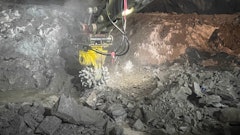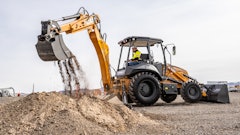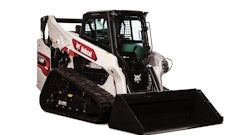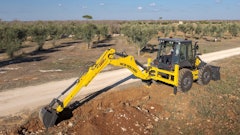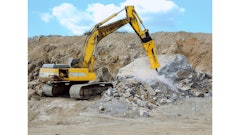
Tractor-loader-backhoes are built tough to withstand harsh working conditions. Yet, a little tender loving care can go a long way toward keeping them up and running, and out of the shop for unscheduled service and repairs.
Daily preventive maintenance is essentially an insurance policy for your equipment - you pay a little up front to prevent costly expenditures and inconvenient downtime later.
"You want the tractor to be available when you need it," says Bob Tyler, product marketing manager for backhoes, John Deere. "The idea is to do daily service so you can get through to regular service intervals. It's about the uptime of the machine - how much it is available to do the work you need it to do. The benefits are that you get to choose when the tractor is down. You get to say when you want to take it off the jobsite for servicing, rather than having it break down at a critical time."
A good place to start with any preventive maintenance program is to read the operator's manual, says Eric Winkler, brand marketing manager for backhoes, New Holland. It will provide specifics about service intervals related to the particular make and model of backhoe-loader you're operating. Plus, it will identify proper operating procedures to promote longevity.
"Operators can get comfortable running equipment over a long period of time. But there are always updates and changes when new models are introduced," Winkler says. "Read the manual so you're familiar with any changes to maintenance intervals."
For example, the introduction of New Holland's new B95 Series simplified some maintenance points with a move to master transmission fluid for hydraulics, shuttle transmission and front and rear axles. And changes three years ago when the company's machines moved from Tier I to Tier II engines lengthened oil service intervals from 250 to 500 hours. "In this case, if you weren't aware of the changes, you may have thrown money away by changing oil more frequently than needed," says Winkler.
Preventive maintenance can also help maintain resale value of your equipment. "If you have used a machine for five years and haven't done anything to it, you likely won't get much for it when you try to sell it," says Winkler.
While all maintenance points are important, make sure to include the following key areas shown here.
Operating Tips for Improved Longevity
In addition to daily maintenance and scheduled service, certain operating practices of your customers can promote - or compromise - the longevity of your backhoe-loader. Remind customers to:
1. Monitor the operating temperature of the fluids, especially in hot ambient temperatures. Make sure you know at what temperature you need to become concerned. That temperature will vary with each engine, transmission or hydraulic system. "You want equipment to run within acceptable operating temperature to prevent serious damage, particularly to seals," says Marcello Bargellini, Volvo.
Some Volvo backhoe-loaders feature a hydraulic safeguard system. When the hydraulic oil temperature reaches a certain point, it reduces the cycle time and monitors it. When the normal operating temperature range is reached, cycle times resume to normal. "This is done so the temperature of the oil will never actually cause seals and other rubber parts to overheat and leak," Bargellini says. "If you don't have this system, you will have to monitor the gauges visually or audibly."
2. Work within recommended capacity limits. Oversized buckets can cause more wear and tear on the machine, notes Jeff Aubrey, Komatsu.
3. Use special attachments wisely. "They may exert different or excessive forces to the machine structure or components," he explains. "Make sure you know how to use those attachments properly, and [check] if any modifications need to be made to the machine."
4. Give a turbocharged engine enough time to adequately warm up. "Wait a minute or two after turning on the machine before revving it to full rpms immediately," says Bob Tyler, John Deere. "That gives time for the oil to circulate at low rpms to the turbo, and for the engine to warm up a little bit. Piston rings can expand and the engine is more efficient, so you're
not wearing metal on metal quite so much."
5. Use the backhoe for its intended purpose. Don't use the bucket as a demolition tool to break up concrete or as a sweeper to push dirt into a trench. "That puts a lot of stress on the wear points on the backhoe," says Eric Winkler, New Holland. "There's a cost to using the machine improperly. If you do certain tasks, expect the life of the machine to go down."
6. Familiarize yourself with any special features of your machine. For example, the Hydraulically Extendable Dipper on New Holland backhoes needs to be adjusted occasionally to maintain maximum control of the bucket.
"Over time, the wear strips will start to wear," says Winkler. "You will have play with the bucket - you won't have as much control over it, which can hurt productivity because you might have to clean up after yourself more."
7. Focus on becoming a smooth operator. "That doesn't necessarily mean to move slower," clarifies Tyler. "Smooth doesn't mean slow. It means being more gentle by not driving the bucket or crowd arm into the stop and by not hitting the extremes of travel at full speed. Other than the sound of the engine, you won't be able to hear a good operator working. There won't be a lot of clanging and banging of the bucket against the stop. That metal-to-metal contact will wear the pins out quicker."
8. Don't compact dirt into the bucket. When you curl a bucket against the crowd arm, dirt - especially a bucketful of wet clay - can be more difficult to dump. "When you tip the bucket, the dirt doesn't always fall out," says Tyler. "Operators then tend to clank or 'rap' the bucket in an effort to remove all the dirt. But that deliberate banging against the stop is very hard on the pin."
Instead, Tyler offers an alternative technique for removing dirt that doesn't drop out. "Boom down and crowd out at the same time," he suggests. "That provides some momentum and gravity to move the dirt out of the bucket."








